The plants and animals within our public lands are an invaluable part of our natural heritage. Ensuring this biodiversity is maintained for generations to come is a complex task. And for the past 50 years, this work has been carried out through partnerships tied together with an important environmental law.
“The 1973 Endangered Species Act has helped us have enduring enjoyment and ecosystem services from wildlife,” said Anne Poopatanapong, a Forest Service wildlife biologist who has worked on species conservation for 26 years. “Conserving any species also conserves the wealth of benefits they provide — from soil restoration, to pest population control, to inspirations for wonder.”
The Endangered Species Act (ESA), signed into law on December 28, 1973, has proven to be incredibly effective, preventing the extinction of 99% of species under its protection. Each successful conservation and recovery project has required the collaboration of many individuals, organizations and agencies.
In California, the U.S. Fish and Wildlife Service often partners with the Forest Service to protect species listed under this act. National forests throughout the state are home to dozens of listed species from frogs and fish, to foxes and fishers. The uninterrupted habitats that extend for hundreds of miles and areas of complete solitude give many species the space to successfully breed and hopefully recover their numbers.
But large, extremely hot fires have ripped through these lands, charring parts of this crucial habitat.
To reduce the risk of these devastating fires, the Forest Service is reducing flammable vegetation and working with the U.S. Fish and Wildlife Service to simultaneously support the conservation of listed species.
Collaborative efforts carry these intertwined goals forward. Wildlife specialists and biologists from each agency review project plans, go out into forests to survey for species and collect data, and analyze the best available science. The Forest Service often includes wildlife conservation measures in its plans, so forest management activities needed to increase forest resilience align with the needs of wildlife.
For example, specific types, sizes and heights of trees are left in areas of the forest known to be actively used as nesting or denning sites by threatened or endangered species. The Forest Service also plans its work to occur during times of the year that will not disrupt key life stages, such as mating season or when adults are caring for young. The U.S. Fish and Wildlife Service reviews these plans before work is started to ensure the species needs are being met.
“The work being completed by the Forest Service will help conserve habitat for listed species in forests across California and reduce the risk of large-scale, high-severity wildfires that impact our communities and wildlife,” said Michael Fris, field supervisor of the U.S. Fish and Wildlife Service’s Sacramento Fish and Wildlife Office.
While the Endangered Species Act spurred the collaboration between the Forest Service and the U.S. Fish and Wildlife Service, the results of the work are far-reaching and will help conserve forest biodiversity for years to come.
Explore the species profiles below to learn a bit about some of the captivating creatures the U.S. Fish and Wildlife Service, Forest Service and partners continue to recover together.
California Spotted Owl
The California spotted owl (Strix occidentalis occidentalis) is a medium-sized brown bird with white spots on its head and chest. It is found in forests across California and Nevada. In 2023, the U.S. Fish and Wildlife Service proposed to provide the owl with protections under the Endangered Species Act listing large-scale, high-severity wildfire as the biggest threat to the bird.
The owl is an excellent hunter, partially due to a large circle of feathers around its eyes, known as a facial disc. Facial discs collect soundwaves and direct the tiniest of noises toward the owl’s ears. This helps the owl pinpoint prey moving through the understory.
While the owls are listening for their next meal, more than 1,700 microphones are out in the forest listening for the owl. Take an audio journey to Sierra National Forest for a lesson on acoustic monitoring from Erin Netoskie, a bioacoustic researcher with the Peery Wildlife Ecology and Conservation Lab. Then, learn more about this work and how wildlife biologists use the data to improve understanding of the owl’s response to wildfires that have impacted the Sierra Nevada.
Fisher
Fishers (Pekania pennanti) may look like a mix between a tiny bear and a cat, but they are in the weasel family. The small mammals have brown or black fur, white patches on their chest, a broad head, pointy snout, bushy tail and small ears. In 2020, the U.S. Fish and Wildlife Service listed the Southern Sierra Nevada distinct population segment of fishers as endangered, noting large-scale, high-severity wildfire as the largest threat to the species.
Fishers eat a variety of foods in the forest. In fact, scientists know fishers are one of the few animals that can successfully hunt and kill porcupines.
The fisher can roam large distances, but they prefer forested areas with a large tree canopy cover with a mix of evergreens and California black oaks. Fishers prefer to stay out of sight while roaming the forest and finding them takes a team.
Join the Region 5 Sierra Nevada Carnivore Monitoring Project out in the woods to hear how experts track the elusive creature. Then, learn how radio collaring on Stanislaus, Sierra and Sequoia national forests, as well as national park lands is helping biologists and land management agencies understand how fishers are responding to wildfire impacts.
Foothill Yellow-legged Frog
The foothill yellow-legged frog (Rana boylii) is named for the yellow shading on its belly and underside of the rear legs. Elsewhere, its skin is generally a mixture of gray, olive and brown. In 2023, the U.S. Fish and Wildlife Service determined that four of the six distinct population segments of the foothill yellow-legged frog required protection under the ESA. The distinct population segments in the South Sierra and South Coast are listed as endangered with those in the North Feather and Central Coast listed as threatened.
While their populations are declining, it’s not for a lack of trying. Female frogs lay one egg mass per year — which can contain anywhere from 100 to 4,000 eggs. Unfortunately, the eggs and frogs are facing challenges in their native streams, from offroading in closed areas, invasive predators like crayfish and bullfrogs, and a fungal pathogen called chytrid.
But for every challenge, there is a team that’s passionate about finding a solution. Read more about how friends of the frogs are working together in Plumas National Forest to crack the code on how best to raise captive eggs and tadpoles for release.
Then, join wildlife biologist, Lauren Hoyle in Tahoe National Forest to find out how a trained eye can find frog eggs among algae and silt and relocate them to waters out of the path of illegal offroading. With a little help, foothill yellow-legged frogs can get a yellow leg up on surviving their most vulnerable years to reach adulthood and lay the eggs of the next generation.











